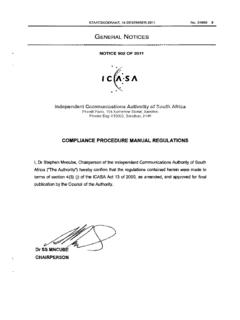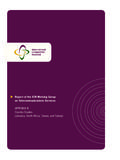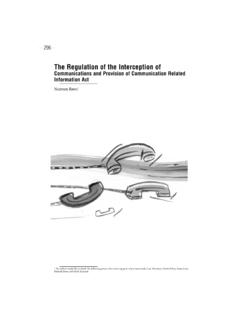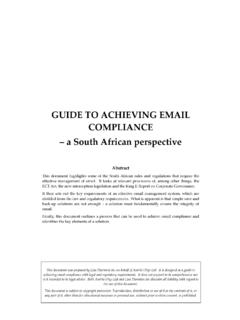Transcription of The Electronic Communications and Transactions Act
1 The Electronic Communications andTransactions ActShumani L. Gereda12621 The author would like to extend his gratitude to Lisa Thornton for affording him the opportunity to be part of this project, and alsothanks Advocate Patrick Mtshaulana for commenting on the ElecComm 5/10/06 2:13 PM Page 262263 IntroductionAnew Communications revolution has created, and continues to create, a neweconomic and democratic landscape. Societies around the globe are drawingcloser to each other and integrating into the global economy throughelectronic communication . This Communications revolution has fundamentallychanged the way the world , the changes have happened so fast that their character andimplications are neither clear nor well understood.
2 People are buying and sellinggoods and services online, either directly or with the help of Electronic are increasingly doing business online and new forms of commercialcooperation are emerging. These Transactions either have brought about or maybring about legal consequences for the parties involved as well as for third partiessuch as online intermediaries and Internet Service Providers (ISPs).Conventional legal frameworks governing the offline world are proving to beinadequate in the online world. Therefore, it has become imperative for nationalgovernments to have in place a clear policy framework for this rapidly developingsector. It was for this and other related reasons, that the Minister ofCommunications commissioned a due diligence survey aimed at identifying lawsthat could constitute barriers to the development of Electronic commerce (e-commerce).
3 The due diligence Report on E-commerce Legal Issues, prepared by aJohannesburg firm of attorneys, led to the launch of the Discussion Paper onElectronic Commerce in July report recommended, amongst otherthings, that the UNCITRAL Model Law on Electronic Commerce form the basisfor introducing primary legislation on commercial Green Paperon Electronic Commerce followed in November 2000, which in turn led to theElectronic Communications and Transactions Act, 25 of 2002 (the ECT Act).4 The ECT Act regulates all forms of Electronic Communications in South Africa,but whether it facilitates Electronic Communications has hitherto been chapter aims to investigate whether the ECT Act facilitates electroniccommunications.
4 In so doing, it focuses on: A comparative analysis of international instruments that influenced the ECT Act, that is, the UNCITRAL Model Law on E-commerce, the OECD Guidelines on E-commerce, and the European Union Policy Directive on E-commerce; The background and overview of the ECT Act, as well as the outstanding provisions of the ECT Act; The Electronic communication legislation of selected foreign countries, in particular the United States of America (US), Australia, the United Kingdom,and Canada; and A comparison of all of the foreign legislation dealt with as well as the international instruments vis- -vis the ECT of Communications Discussion Paper on Electronic Commerce(July 1999). (The Discussion Paper was launched with aspecialised website: [07 September 2003].)
5 3T James An Information Policy Handbook for Southern Africa A Knowledge Base for Decision-Makers(IDRC, 2001) 23708 dated 2 August L. Gereda10 ElecComm 5/10/06 2:13 PM Page 263 The conclusion of this chapter is that, comparatively speaking, the ECT Act doeshave the potential to facilitate the use of Electronic INTERNATIONAL REGULATION OF Electronic COMMUNICATIONST here are international guiding instruments that many states consult in developingtheir own appropriate state laws, such as the United Nations Commission onInternational Trade Law s Model Law on Electronic Commerce of 16 December1996 (The Model Law)5and the OECD Guidelines for Consumer Protection in theContext of Electronic Commerce (The Guidelines).
6 The United Nations GeneralAssembly established the United Nations Commission on International Trade Law(Commission) in 1966 by resolution 2205(XXI) of 17 December 2003, the commission increased its membership from 36 to hasestablished six working groups composed of all member states of the Group IV on e-commerce is responsible for the Model Law and theoverall development of e-commerce relating to international The Model LawOn 16 December 1996, the United Nations General Assembly passed a resolutionthat led to the adoption of the Model Law. The General Assembly stated that:Noting that an increasing number of Transactions in international trade arecarried out by means of Electronic data interchange and other means ofcommunication, which involve the use ofalternatives to paper-based methods ofcommunication and storage of information.
7 Recommends that all States give favourable consideration to the Model Lawwhen they enact or revise their laws, in view of the need for uniformity of the lawapplicable to alternatives to paper-based methods of communication and storage ofinformation ..9 The aim of the Model Law is to provide national legislatures with a template ofinternationally acceptable rules to remove legal obstacles and create a more securelegal environment for Electronic commerce. The Model Law intends to facilitatethe use of Electronic Communications by encouraging the internationalharmonisation of domestic legal rules for Electronic 2 of the Model Law defines the originator of a data message as a personby whom, or on whose behalf, the data message purports to have been sent orgenerated prior to storage, if any; but it does not include a person acting as anintermediary with respect to that data message.
8 Article 2 of the Model Law furtherdefines the addressee of a data message as a person who is intended by the2645 The General Assembly Resolution 51/162 of 16 December 1996: Uncitral Model Law on Electronic Commerce in United NationsCommission on International Trade Law (UNCITRAL) Status of Conventions and Model Laws; available at Assembly Resolution 2205(XXI) of 17 December 1966; available at by Dr M Gandhi, Counsellor & legal adviser on agenda item 151: Report of the United Nations Commission onInternational Trade Law on the work of its thirty-sixth session at sixth committee of 58th Unga on 6 October 2003; available Working Groups. The structure of the Working Groups and their responsibilities are provided in the UNCITRAL websiteat General Assembly Resolution 51/162 of 16 December 1996:UNCITRAL Model Law on Electronic Commerce.
9 The resolution isavailable online at Communications and Transactions Act10 ElecComm 5/10/06 2:13 PM Page 264265originator to receive the data message, but does not include a person acting as anintermediary with respect to that data The Model Law on e-Signatures In 2001, the Commission adopted the Model Law on Electronic -Signatures withthe intention of bringing additional legal certainty regarding the use of Model Law on e-signatures is built on the flexible principlecontained in article 7 of the Model Law, which establishes a presumption that,where they meet certain criteria of technical reliability, Electronic signatures shallbe treated as equivalent to handwritten signatures.
10 The Model Law on Electronic -Signatures applies where e-signatures are used in the context of commercialactivities, without overriding any rule of law intended for the protection The Organisation for Economic Co-operation and Development(OECD)The OECD succeeded the Organisation for European Economic Co-operation (theOEEC), which was formed to administer American and Canadian aid under theMarshall Plan for the reconstruction of Europe after the Second World War. Since ittook over from the OEEC in 1961, the OECD has set out to build strong economies inits member countries. In recent years, the OECD has moved beyond a focus on itsmember countries to offer its analytical expertise and accumulated experience todeveloping market OECD has 30 members and currently involves in its work approximately 70non-member countries.





